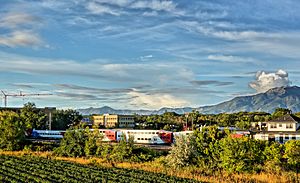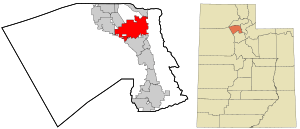Layton, Utah facts for kids
Quick facts for kids
Layton, Utah
|
||
|---|---|---|

Historic Downtown Layton
|
||
|
||

Location within Davis County and the State of Utah
|
||
| Country | United States | |
| State | Utah | |
| County | Davis | |
| Settled | 1850s | |
| Incorporated | May 24, 1920 | |
| City | 1950 | |
| Named for | Christopher Layton | |
| Government | ||
| • Type | Council–manager | |
| Area | ||
| • Total | 22.65 sq mi (58.67 km2) | |
| • Land | 22.50 sq mi (58.27 km2) | |
| • Water | 0.16 sq mi (0.40 km2) | |
| Elevation | 4,459 ft (1,359 m) | |
| Population
(2020)
|
||
| • Total | 81,773 | |
| • Density | 3,634.36/sq mi (1,403.35/km2) | |
| Time zone | UTC−7 (Mountain (MST)) | |
| • Summer (DST) | UTC−6 (MDT) | |
| ZIP codes |
84040, 84041
|
|
| Area code(s) | 385, 801 | |
| FIPS code | 49-43660 | |
| GNIS feature ID | 2411639 | |
Layton is a city located in Davis County, Utah, in the western United States. It is part of a larger metropolitan area that includes Ogden and Clearfield. In 2020, about 81,773 people lived there. By 2024, the population was estimated to be around 87,392. Layton is the biggest city in Davis County and the ninth largest in Utah.
The city offers easy travel to major places like Salt Lake City and Ogden. It also has good connections to the Salt Lake City International Airport and the FrontRunner train. Layton is important for business in its area. It is close to Hill Air Force Base, which is a large employer. The city also has many hotels, a conference center, the Layton Hills Mall, and lots of shops and restaurants. Weber State University has a campus here too.
Layton is a busy place for shopping. In 2014, it had the second-highest amount of retail sales north of Salt Lake City. It was also the seventh-largest shopping area in all of Utah.
Contents
History of Layton
How Layton Began
Layton was first settled in the 1850s. It grew out of a nearby town called Kaysville. The city is named after Christopher Layton, an early settler and leader of the Church of Jesus Christ of Latter-day Saints. When Kaysville became a city in 1868, Layton was part of it.
However, by the 1880s, many people in Layton wanted to be separate. They felt they were not getting city services for the taxes they paid. This argument even went to the United States Supreme Court in 1894. The court decided that Layton property owners were right. In 1902, Layton became its own independent area. It grew more and became an official town in 1920.
Layton's Growth Over Time
Layton's population grew slowly at first. By 1940, only about 600 people lived there. But then, Hill Air Force Base was built nearby in 1940. Soon after, the United States entered World War II. These events caused Layton's population to grow very quickly. Many people moved there for war jobs. By 1950, the city had 3,456 people. Layton changed from a small farming town to a place where many people lived.
After the war, growth slowed down. But Layton kept growing as a commuter town. This means people lived in Layton but traveled to work in Salt Lake City or Ogden. The city also grew by adding more land. It took in nearby towns like Laytona and East Layton. In 1985, Layton became the most populated city in Davis County, passing Bountiful.
Where is Layton Located?
Layton is in the northern part of the Wasatch Front. This area is about 25 miles (40 km) north of Salt Lake City. It is also about 15 miles (24 km) south of Ogden.
Layton shares borders with several other places:
- Clearfield to the northwest.
- Hill Air Force Base to the north.
- South Weber to the northeast.
- The Wasatch Mountains to the east.
- Kaysville to the south.
- Great Salt Lake wetlands to the southwest.
- Syracuse to the west.
The United States Census Bureau says Layton covers about 22.16 square miles (57.4 km2). Most of this area is land, with a small part being water.
Layton's Climate
Layton has hot summers and cold winters. In winter, it often gets snow caused by the Great Salt Lake effect. This happens when cold air moves over the warmer lake water, creating snow.
People Living in Layton
| Historical population | |||
|---|---|---|---|
| Census | Pop. | %± | |
| 1930 | 597 | — | |
| 1940 | 646 | 8.2% | |
| 1950 | 3,456 | 435.0% | |
| 1960 | 9,027 | 161.2% | |
| 1970 | 13,603 | 50.7% | |
| 1980 | 22,862 | 68.1% | |
| 1990 | 41,784 | 82.8% | |
| 2000 | 58,474 | 39.9% | |
| 2010 | 67,311 | 15.1% | |
| 2020 | 81,773 | 21.5% | |
| 2022 (est.) | 82,601 | 22.7% | |
| U.S. Decennial Census | |||
What is Layton's Population Like?
In 2020, Layton had 81,773 people. The table below shows the different groups of people living in Layton. It includes information on race and ethnicity. Hispanic/Latino is an ethnic group, and people from any race can be Hispanic/Latino.
| Race / Ethnicity (NH = Non-Hispanic) | Pop 2000 | Pop 2010 | Pop 2020 | % 2000 | % 2010 | % 2020 |
|---|---|---|---|---|---|---|
| White alone (NH) | 50,820 | 55,215 | 62,699 | 86.91% | 82.03% | 76.67% |
| Black or African American alone (NH) | 907 | 1,067 | 1,126 | 1.55% | 1.59% | 1.38% |
| Native American or Alaska Native alone (NH) | 255 | 251 | 421 | 0.44% | 0.37% | 0.51% |
| Asian alone (NH) | 1,178 | 1,353 | 1,796 | 2.01% | 2.01% | 2.20% |
| Pacific Islander alone (NH) | 141 | 342 | 526 | 0.24% | 0.51% | 0.64% |
| Other race alone (NH) | 61 | 99 | 345 | 0.10% | 0.15% | 0.42% |
| Mixed race or Multiracial (NH) | 1,044 | 1,473 | 3,533 | 1.79% | 2.19% | 4.32% |
| Hispanic or Latino (any race) | 4,068 | 7,511 | 11,327 | 6.96% | 11.16% | 13.85% |
| Total | 58,474 | 67,311 | 81,773 | 100.00% | 100.00% | 100.00% |
Schools and Learning in Layton
Layton is part of the Davis School District. It also has a branch campus of Weber State University. The city has many schools for students of all ages.
High Schools in Layton
- Layton High School (opened 1966)
- Northridge High School (opened 1992)
- NUAMES—Northern Utah Academy of Math, Engineering & Science (opened 2004). This is a special charter high school that works with Weber State University.
- Layton Christian Academy (opened 1993). This is a private Christian school.
Junior High Schools in Layton
- Central Davis Junior High
- Legacy Junior High
- North Davis Preparatory Academy Junior High
- North Layton Junior High
- Shoreline Junior High
- Layton Christian Academy
Elementary Schools in Layton
- Sarah Jane Adams Elementary
- Crestview Elementary
- Ellison Park Elementary
- East Layton Elementary
- Heritage Elementary
- E.G. King Elementary
- Layton Elementary
- Lincoln Elementary
- Mountain View Elementary
- North Davis Preparatory Academy Elementary
- Sand Springs Elementary
- Sunburst Elementary
- Vae View Elementary
- E. M. Whitesides Elementary
- Layton Christian Academy
Getting Around Layton
Roads and Highways
I-15 is a major highway that runs through the middle of Layton. It has three exits in the city: Antelope Drive, Hillfield Road, and Layton Parkway. U.S. 89 runs along the eastern side of Layton, near the Wasatch Mountains. It connects to I-84 to the north and merges with I-15 to the south.
Other important roads include:
- Utah State Route 177: This road goes north-south through western Layton. It connects different communities in western Davis County.
- Utah State Route 193: This road goes east-west through northern Layton. It passes the south gate of Hill Air Force Base and connects U.S. 89 to I-15.
Public Transportation
The Utah Transit Authority (UTA) provides bus service in Layton. It also runs the FrontRunner commuter rail. The Layton Station for the FrontRunner train is located where an old train station used to be.
Fun Places to Visit in Layton
Layton has many interesting places to visit and things to do.
Shopping and Entertainment
The main shopping area in Layton includes the Layton Hills Mall. There are also movie theaters and the Davis Conference Center. A street nicknamed "Restaurant Row" has many national chain restaurants.
City Center Attractions
Layton's City Center is where the city offices, police station, and courthouse are located. Nearby, you can find:
- Layton Commons Park
- Davis Arts Council
- Davis County Library Central Branch
- Edward A. Kenley Centennial Amphitheater
- Heritage Museum of Layton
- Layton Surf 'N Swim (a swimming facility)
- Layton High School
Outdoor Adventures
Adams Canyon is a popular place for hiking. It is located east of Highway 89. Along the trail, you can see plants like Gambel Oak and Douglas Fir. You might also spot chipmunks and different kinds of birds. The hiking trail is about 3.7 miles (6 km) long, going out and back.
Religious Sites
On April 1, 2018, Russell M. Nelson, the leader of the Church of Jesus Christ of Latter-day Saints, announced plans to build the Layton Utah Temple. Construction finished in June 2024, and the temple was officially opened on June 16, 2024. It is the 22nd temple in Utah.
Parks and Trails in Layton
Layton has many parks and trails for outdoor activities:
- Andy Adams Park (1713 E 1000 N)
- Bamberger Trail
- Camelot Park (1400 W 2000 N)
- Chapel Park (152 S 900 E)
- Chelsie Meadows Park (1401 N 2575 W)
- D&RG Trail
- Ellison Park - Splash Pad & Skate Park (700 N 2200 W)
- Grey Hawk Park (3500 Redtail Way)
- Kays Creek Parkway (Multiple Trail Heads)
- Layton Commons Park (437 N Wasatch Dr)
- Legacy Park (469 N 3200 W)
- Oak Forest Park (2250 E 2400 N)
- Sandridge Park (2555 N Church St)
- Vae View Park (1600 N Main)
- Veterans Park (175 W Gentile St)
- Woodward Park (1505 N 25 E)
Famous People From Layton
Many notable people have connections to Layton:
- Julian Blackmon, an NFL football player
- Christine Cavanaugh, a voice actress known for the movie Babe
- Daniel Coats, a former NFL player
- John Collins, a basketball player drafted in 2017
- R Adams Cowley, a surgeon who helped create modern trauma care
- Tiffany Coyne, a model on the TV show Let's Make a Deal
- Chuck Ehin, an NFL player
- Sherman L. Fleek, a military historian
- Kevin Garn, a former leader in the Utah House of Representatives
- Dayan Lake, an NFL football player
- Shaun Todd McBride, an artist and social media personality
- Court McGee, a mixed martial artist who fights in UFC
- Ruby Timms Price, the first Black teacher in Utah
- Sterling W. Sill, a leader in the Church of Jesus Christ of Latter-day Saints and a local businessman
- Calvin Lee Vail, also known as LeafyIsHere, a YouTube personality
Local Music Groups
- Get Scared, a heavy metal band from Layton
See also
 In Spanish: Layton (Utah) para niños
In Spanish: Layton (Utah) para niños


